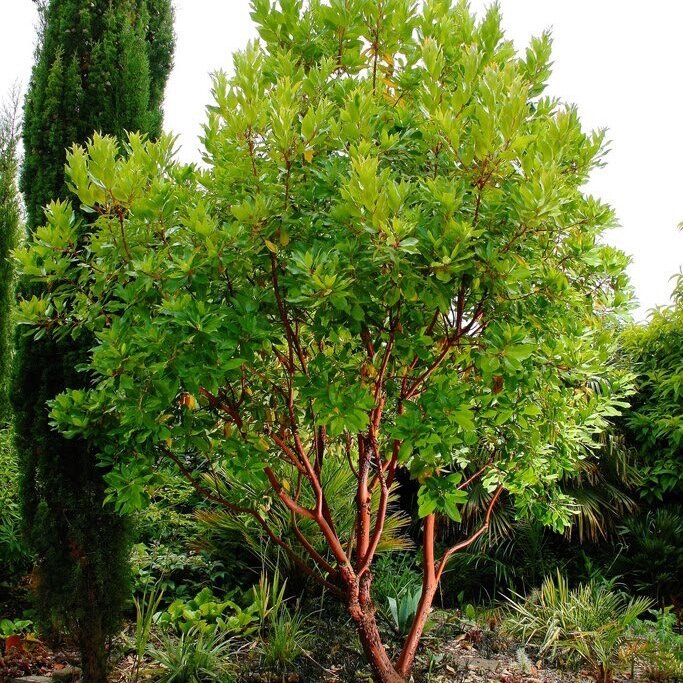28.10.19
10 FAVOURITE GARDEN TREES + 2
There is no garden without trees in my view, even the tiniest gardens can accommodate a tree, as long as you choose the right one for the right place. They are invaluable for wildlife, bring scale, are low maintenance, have a cooling effect as well as help with flooding.
I have struggled to choose stick to 10 only, so here it is 10 + 2.., still painful, in no particular order.
1 Prunus ‘Accolade’
One of the earliest flowering cherries, it celebrates the arrival of Spring with its abundant blossom in March. Breathtakingly luminous on the dull days of March, and again in Autumn when its foliage glows yellow and orange. If you can find one that has been grown as a multi-stem, it will make the most amazing specimen tree.
2 Malus ‘Evereste’
Probably my favourite crab apple, it has a compact, broadly round, tidy crown that makes it an excellent choice for smaller gardens.
It is a great choice to bring colour in the spring as well as the autumn and being a late spring flowerer is useful planted with an early flowering tree; a Magnolia or an early flowering cherry such as Prunus Accolade, this will stretch the colour in your garden over the longest period possible.Excellent for wildlife as per all crab apples.
3 Malus hupehensis
Malus hupehensis or Tea Crab Apple (Chinese people used to brew the leaves were brewed to make tea ) is one of the most prolific flowering crab apple trees. A mass of small, red crab apples that look like cherries appear in autumn. These crab apples will usually hang on until the winter, providing a vital source of food for wildlife.
4 Sorbus ‘Joseph Rock’
Perfect native tree for small gardens, reaching perhaps 4m after 10 years. It has a spectacular Autumn colour and is good for wildlife.
5 Sophora japonica
A delightful and interesting specimen that, despite its common name (Japanese Pagoda Tree) , is native to China, although is widely planted in Japan. Good pollinator
6 Cornus mas
A very interesting small tree (more a shrub really), perfect in a multi-stemmed form, it is underused in my view. Its bark and silhouette are attractive, it flowers on bare stems in March when not much else is going on in the garden and provides fruits that make a deliciously zingy chutney. Or leave the fruits for the birds to enjoy.
7 Acacia pravissima
I came across this tree at a client of mine for the first time, having never seen it before. Embarassingly I wasn’t quite sure what to do with it or whether it could be pruned or else. Since then I have fallen in love with it, and never cease to marvel at it everytime I walk or drive past it. It responded very well to pruning by the way.
8 Rhus typhina
Stag's horn sumach is an excellent, very architectural tree specimen for a small sunny garden, but as it spreads by suckering, avoid planting it too close to a lawn. One of the best trees for Autumn colour.
9 Salix Caprea (Goat or Pussy willow)
This willow grows well away from water and the rounded leaves are completely different to the narrow leaves of other willows. It is covered in downy white buds in spring which are popular with florists. The buds open to form an abundance of fluffy, yellow and honey scented flowers.
10 Arbutus x andrachnoides
This wonderful tree makes my heart skip a beat and reminds me of the Arbutus unedo trees in my childhood garden in South of France. It’s not easy to source and needs good drainage and sun. It grows into interesting gnarled and architectural shapes and its cinnamon red bark is striking.
11 Toona sinensis ‘Flamingo’
In spring, its big leaves emerge a bright salmon pink, a colour that you never see in gardens, quite extraordinary, and gradually change colour to creamy yellow and later rich green in summer. All parts of the plant are scented and the wood is often burnt in temples in Eastern Asia to infuse them with its delicate scent.
12 Melia azedarach (Bead tree, Pride of China, Pride of India)
A rare but attractive tree more common in the Mediterranean, it bears fragrant lilac flowers and bead -like fruits that remain long after the leaves have fallen. It will only grow in mild parts of the UK. Caution: Leaves and berries are toxic.



